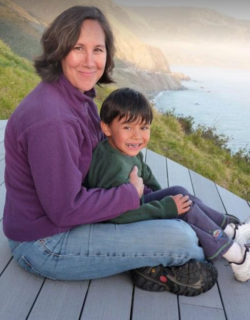
Sanctuary 30th Anniversary Series – Blog #13 “Finding sanctuary: Expanding on successes of last 30 years” by Lisa Wooninck
Today, I expand on the collaborations Monterey Bay National Marine Sanctuary has built since its designation 30 years ago by sharing the water quality improvements achieved with the “ag” community, and exciting deep-sea discoveries made at a newly protected habitat of the sanctuary.
AQWA for Aqua Quality
Water quality is key to ensuring protection for all sanctuary resources. Using a voluntary stewardship approach, farmers, ranchers, researchers, and resource conservation agencies come together to protect water quality of the sanctuary from agricultural practices. Their foundational vision for collaboration is “Together we will protect and enhance water in the sanctuary and adjacent watersheds while sustaining a world class production agriculture region through voluntary collaboration with managers of agriculture and rural lands.” The award-winning Agriculture Water Quality Alliance (AQWA) program has implemented thousands of best management practices with the ag community to improve water quality of the sanctuary over its 20 year history.
These practices include reducing runoff of sediments, nutrients and pesticides from ag and rural lands through nutrient and irrigation management, vegetated treatment systems, and buffer strips, to name a few. It’s gratifying to share that according to the 2021 report from the Central Coast Long-term Environmental Network, water quality of the sanctuary has indeed improved. Scientists detected declines, over the last 20 years, in concentrations of harmful chemicals (e.g. PCBs and DDTs) in sediments of Monterey Bay and mussel tissue collected at Pleasure Point in Santa Cruz.
Promising plastic pilot project

In the past several years, we have also collaborated with farmers, ranchers, the California Marine Sanctuary Foundation and The Nature Conservancy to take on plastic pollution, specifically plastic from agriculture operations. After doing some reconnaissance to determine the scope and magnitude of the issue, we have established drop off locations for recycling of drip irrigation tape and initiated a biodegradable mulch (BDM, i.e., plastic sheeting in the fields) pilot study to determine if BDM will work for growers on the Central Coast and how fast it biodegrades in the soil.
While the water quality monitoring results are promising and the plastic work is exciting, we must remain vigilant and continue to work together with our partners as well as extend our network of stakeholders to reduce contaminated runoff in rivers and storm drains from entering our sanctuary.
Davidson’s depths
From the agricultural fields to 75 miles west of San Simeon, where we find Davidson Seamount, which is an extinct volcano that rises up from the seafloor to 7,500 feet tall, but is still 4,100 feet from the sea surface. The first expedition in 2002 to Davidson Seamount was led by a collaboration of local scientists from Monterey Bay Aquarium Institute, Monterey Bay Aquarium, Moss Landing Marine Laboratories, and the sanctuary. Utilizing remotely operated vehicles (ROVs) equipped with cameras the researchers document their early findings. Glimpses of the then largely mysterious habitat peaked national interest. The entire seamount resides in cold, dark water, and is yet surprisingly covered with a plethora of life –from colorful basket stars to huge sponges, rare deep-sea fishes to fragile “old-growth” corals, some of which are hundreds of years old. The captivating images of the seamount inspired the sanctuary’s research coordinator, Andrew DeVogelaere, to launch subsequent collaborative explorations of the seamount to learn more about the relatively pristine habitat.
The results of these early explorations formed the basis of the Monterey Bay National Marine Sanctuary expansion in 2008 to include the Davidson Seamount Management Zone. The expansion added 775 square miles of a unique habitat with special national significance to the sanctuary. Protection of the seamount from potential harmful activities is achieved through use of federal fisheries authorities and the National Marine Sanctuaries Act.
Deep-sea discoveries
Since the addition of Davidson Seamount, a number of expeditions have revealed additional thrilling discoveries. For example, in 2018, a team of sanctuary and partner scientists “stumbled upon” hundreds of female brooding octopus on the flanks of the seamount, at 10,000 feet depth. On another expedition, a whale fall (a sunken whale carcass) was discovered on the flat seafloor nearby.
The whale fall discovery and following surveys offered the rare opportunity to assess the condition of the carcass over time and to document species new to science. Whale falls create nutrient-rich oases within food scarce areas of the deep sea for a series of scavengers to devour the large carcass, including the blubber, organs, and bones. You can view “Discover Wonder,” a short film about these discoveries at the Sanctuary Exploration Center in Santa Cruz.
 Monterey Bay National Marine Sanctuary Superintendent Dr. Lisa Wooninck began as a research fishery biologist at NOAA Fisheries headquarters and the Santa Cruz lab, joined the sanctuary as a policy analyst, and then the West Coast Regional team in 2010 as the policy coordinator. She has a Ph.D. in ecology and evolutionary biology from UC Santa Barbara.
Monterey Bay National Marine Sanctuary Superintendent Dr. Lisa Wooninck began as a research fishery biologist at NOAA Fisheries headquarters and the Santa Cruz lab, joined the sanctuary as a policy analyst, and then the West Coast Regional team in 2010 as the policy coordinator. She has a Ph.D. in ecology and evolutionary biology from UC Santa Barbara.
About this series
Monterey Bay National Marine Sanctuary is celebrating its 30th anniversary, and the national sanctuary system its 50th anniversary. In recognition of these milestones, the Sentinel has been publishing columns by former U.S. Secretary of Defense Leon Panetta, former U.S. Rep. Sam Farr, former Save Our Shores Director Dan Haifley, and former California Assemblymember Fred Keeley, who serve on the board of Monterey Bay National Marine Sanctuary Foundation and were involved with the sanctuary’s designation, as well as Sanctuary Superintendent Dr. Lisa Wooninck. For information, visit montereybayfoundation.org or montereybay.noaa.gov.

